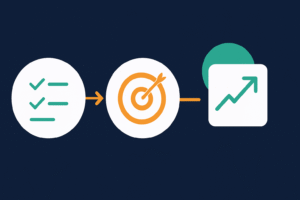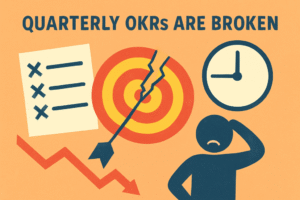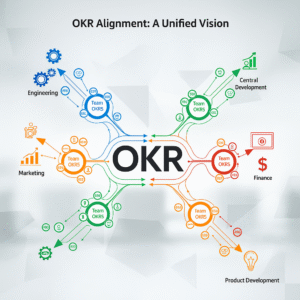In the modern corporate landscape, organizations invest significant resources—time, money, and energy—into initiatives designed to drive growth, efficiency, and success. Yet, paradoxically, many organizations suffer from “benefit blindness”, a phenomenon where employees and leaders alike fail to see or connect their efforts with tangible benefits. Organizational impact invisibility feels like the company is “flying blind” and this is a scary proposition. This disconnect is not just an individual challenge; it is a systemic problem that can diminish motivation, misallocate resources, and weaken strategic alignment.
The Roots of Benefit Blindness
Hierarchical
Benefit blindness arises from several key factors, many of which are deeply embedded in corporate structures and cultures. One of the primary causes is the increasing complexity of modern organizations. In large companies, strategy, execution, and outcomes are often separated by multiple layers of hierarchy and function, making it difficult for individuals to perceive the direct impact of their contributions. An employee in a multinational corporation working on a small component of a large project may struggle to see how their work contributes to the final product or service.
A large program in an enterprise organization arranged for an entire team of people to handle the interactions with the customers. This Customer Experience Team seemed like a good idea but just added another layer of insulation purposedly designed to separate the people working on the project from the people who would use the project. When questions, feedback, and communications are carefully curated, the potential benefit can easily get lost.
Temporal
Another significant factor is the time lag between effort and benefit realization, often measured in terms of long cycle times. Many strategic initiatives, particularly those related to innovation, infrastructure, or culture change, take months or even years to bear fruit. Employees and even managers who are deeply involved in these efforts may move on to other roles or organizations before they can witness the benefits of their work. This delay erodes motivation and fosters a sense of futility in ongoing initiatives.
Quantitative
Additionally, benefit blindness is exacerbated by the way organizations measure and communicate success. While businesses rely on key performance indicators (KPIs) and metrics to track progress, these measurements often fail to link back to the individual contributors who made success possible. When organizations celebrate overall achievements without highlighting the incremental contributions that led to them, employees may feel disconnected from the positive outcomes they helped create. Add to this the fact that anticipated benefits written into the original business plan are frequently not measured, or are not appropriate once the product hits the market, or forgotten about over the length of the project, and it becomes very difficult to determine if the original objectives have been met. The lack of a “dashboard of instruments” is one of the biggest factors leading to the feeling of flying blind.
A leader of one important optimization project lamented that they “could not see what was happening, could not tell what was being produced, and and no idea if the real problem was getting any better.” The lack of measurements and feedback cycles was frustrating. They worried that the teams were working on the wrong thing. Couple this with KPIs that were not designed to measure the effect of the project and there was a complete disconnect of effort from benefit.
Psychological
Psychological factors also play a role. The human brain is wired to seek immediate feedback and gratification, but in corporate settings, such immediate reinforcement is often missing. When employees do not receive timely and clear reinforcement of the value of their work, they may assume their efforts are inconsequential, even if they are making a meaningful impact. Over time, this can lead to disengagement and decreased productivity.
Giving teams an objective they can agree on and strive for is a way organizations can overcome the psychological impacts by giving teams the autonomy to work towards and aligned objective of their design using OKR.
The Organizational Impact of Benefit Blindness
Misalignment
The first and perhaps biggest impact is that benefit blindness can weaken strategic alignment. If employees and middle managers do not understand how their daily activities contribute to broader business objectives, they may prioritize the wrong tasks or make decisions that do not align with corporate strategy. This misalignment can dilute the effectiveness of strategic initiatives and slow down the organization’s ability to respond to market changes, and ultimately result in missing the goals set out at the beginning.
Misallocation
Moreover, benefit blindness can lead to the misallocation of resources. When leaders and decision-makers do not have a clear view of the impact of various initiatives, they may invest in projects that appear promising but ultimately fail to deliver results. Conversely, they may neglect or underfund initiatives that are yielding positive benefits simply because those benefits are not immediately visible. This misalignment can cause inefficiencies and prevent organizations from optimizing their investments.
Leaders may also be unable to respond quickly enough to changing circumstances. Without measurable feedback; teams, people, time, money can all be spent on the what started out as the right thing, but unwittingly became the wrong thing as circumstances changed without our knowledge.
Employee – Effort Disconnection
The consequences of benefit blindness are far-reaching and can undermine an organization’s ability to execute its strategy effectively. One of the most significant impacts is the erosion of employee engagement. This is one of the often overlooked causes of employee disengagement. When people feel disconnected from the outcomes of their work, they are less likely to be motivated, innovative, or committed to organizational goals. This can result in increased turnover, absenteeism, and lower overall productivity.
Knowledge/Skill Leak
Another serious consequence is the loss of domain knowledge. When employees do not see the impact of their work, they are more likely to leave for roles where they feel more valued. As these employees depart, they take their knowledge, skills, and insights with them, creating a knowledge gap that can hinder the organization’s long-term growth and competitiveness. The inability to retain institutional knowledge forces organizations into cycles of reinventing the wheel, reducing efficiency and innovation.
A lack of visible benefits can also foster a culture of skepticism and resistance to change. When employees fail to see how past initiatives have delivered value, they may become resistant to new initiatives, assuming that they, too, will lead to no meaningful outcomes. This cynicism can become embedded in corporate culture, making future change efforts even more difficult to implement.
The Ripple Effect of Benefit Blindness
The effects of benefit blindness do not stop at the organizational level—they extend to customers, partners, and even industry reputation. When employees are disengaged and demotivated, customer service quality may suffer, leading to a decline in customer satisfaction and loyalty. Similarly, when an organization misallocates resources or struggles with inefficiencies, it may fall behind competitors who have a clearer understanding of how their efforts translate into business success.
Additionally, organizations that suffer from benefit blindness may struggle to attract top talent. High-performing professionals seek workplaces where their contributions are recognized and valued. If a company has a reputation for failing to acknowledge the impact of individual and team efforts, it may find it difficult to recruit and retain the talent necessary for sustained success.
Conclusion
Benefit blindness is not just an internal inefficiency—it is a strategic vulnerability. It is just as dangerous as trying to fly a plane without visibility or instruments, and just as scary for leaders trying to succeed. Organizations that fail to address this issue risk creating environments where effort is expended without recognition, innovation is stifled by disengagement, and long-term success is compromised by the misalignment of goals and actions. While many organizations recognize the importance of tracking performance and measuring success, few pay attention to whether their employees and managers actually perceive and internalize the benefits of their work. Until organizations tackle this hidden challenge, they may continue to miss the full impact of their efforts.




